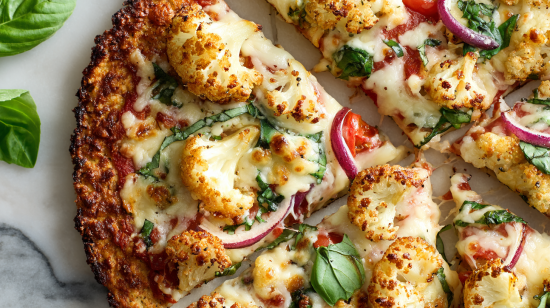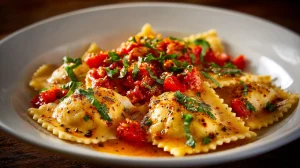
bettergoods Gluten-Free Cauliflower Thin Crust Pepperoni Pizza, 12.1 oz (Frozen)
- bettergoods Gluten-Free Cauliflower Thin Crust Pepperoni Pizza, 12.1 oz (Frozen)
- Made with real low-moisture part-skim mozzarella and white cheddar cheeses on a cauliflower crust and topped with pepperoni
- Made without artificial colors and flavors
- 300 calories per serving
- 3 servings per container
- Bake it in the oven at 425 degrees F for 13 to 15 minutes
$5.97
Discovering Delicious Alternatives to Traditional Pizza Without Sacrificing Flavor
I still remember the skeptical look on my face when my nutritionist first suggested I try cauliflower pizza. “There’s no way that’s going to satisfy my Friday night pizza cravings,” I thought to myself. Fast forward three years, and I’m now what you might call a cauliflower pizza connoisseur. After trying virtually every brand on the market, I’ve finally found what I consider to be the holy grail of cauliflower crusts: Bettergoods Cauliflower Pizza. This comprehensive guide represents my personal journey with this game-changing product, and I’m excited to share everything I’ve learned along the way.
What Exactly Is Bettergoods Cauliflower Pizza?
Before diving into the nitty-gritty details, let’s start with the basics. Bettergoods Cauliflower Pizza is exactly what it sounds like – a pizza that uses a crust made primarily from cauliflower instead of traditional wheat flour. But it’s so much more than that. It represents a revolution in alternative pizza options that doesn’t force you to compromise on taste or texture.
When I first discovered Bettergoods, I was immediately intrigued by their commitment to creating a product that genuinely tastes good while providing a healthier alternative to traditional pizza. The company started in 2018 when founder Jamie Collins (a self-proclaimed pizza addict) was diagnosed with gluten sensitivity. Unwilling to give up his favorite food, he spent two years perfecting a cauliflower crust recipe in his home kitchen before launching Bettergoods.
What sets Bettergoods apart from other cauliflower pizza brands I’ve tried is their unique cooking process. They use a specialized technique that removes excess moisture from the cauliflower before forming the crust, which solves the soggy-center problem that plagues many other cauliflower pizzas. The result is a crust that actually crisps up around the edges while maintaining a pleasant chewiness in the center – something I previously thought impossible with vegetable-based crusts.
My Hunt for Bettergoods: Where to Find This Elusive Pizza
Finding Bettergoods Cauliflower Pizza wasn’t exactly straightforward at first. When I initially heard about it from a friend at my CrossFit gym, I immediately checked my local supermarket only to come up empty-handed. After some research (and mild pizza-induced desperation), I discovered several reliable places to purchase it.
Most major health food stores like Whole Foods and Sprouts regularly stock Bettergoods in their freezer sections. I’ve also found it at larger supermarket chains like Kroger, Safeway, and Target, though availability can vary by location. If you’re having trouble locating it locally, their official website offers a store locator tool that I found incredibly helpful.
For those who prefer online shopping (like me during the pandemic), Bettergoods is available through various online grocery delivery services including Instacart, Amazon Fresh, and Thrive Market. I’ve even ordered directly from their website when I wanted to stock up with their bulk discount offers.
One insider tip I’ve learned: check the specialty frozen foods section rather than the regular frozen pizza area. Many stores place Bettergoods with other specialty health foods rather than alongside conventional frozen pizzas.
The Gluten-Free Question: Yes, But Is It Actually Good?
Let’s address one of the most common questions right away: Bettergoods Cauliflower Pizza is 100% gluten-free, which was a major selling point for me. Having experimented with reducing gluten in my diet for digestive reasons, finding a truly satisfying gluten-free pizza option felt like discovering buried treasure.
But here’s the thing that truly impressed me – Bettergoods doesn’t just meet the technical requirements for being labeled gluten-free. Many products achieve this benchmark but fall short on taste and texture. The first time I tried Bettergoods, I had to double-check the packaging because I couldn’t believe something so satisfying could be completely free of wheat.
The company takes their gluten-free commitment seriously, producing their pizzas in a dedicated gluten-free facility to prevent any cross-contamination. This level of care is particularly important for those with celiac disease or severe gluten sensitivities.
I once served Bettergoods at a dinner party without telling my guests it was gluten-free. The pizza disappeared within minutes, and when I revealed its cauliflower secret, no one believed me. That’s when I knew this wasn’t just “good for a gluten-free option” – it was legitimately delicious by any standard.
Breaking Down the Ingredient List: What’s Actually in This Thing?
As someone who’s become increasingly ingredient-conscious over the years, I appreciate that Bettergoods maintains a relatively clean and straightforward ingredient list. The primary ingredients include:
- Cauliflower (obviously)
- Rice flour (helps with binding and texture)
- Potato starch
- Olive oil
- Sea salt
- Italian herbs
- Yeast (for that authentic pizza flavor)
What you won’t find are the lengthy lists of unpronounceable additives and preservatives that dominate many frozen food products. This cleaner approach to ingredients aligns perfectly with my goal of eating more whole foods without becoming obsessive about it.
I particularly appreciate that they use olive oil rather than cheaper alternatives like canola or soybean oil. These small details make a difference both in flavor and nutritional quality. The yeast addition is genius too – it gives the crust that subtle fermented flavor that makes traditional pizza so addictive.
The Dairy Dilemma: Options for Everyone
When it comes to dietary restrictions, dairy is often another major consideration. The good news is that Bettergoods offers both dairy and dairy-free options in their product line.
Their plain cauliflower crusts are completely dairy-free, making them suitable for those with lactose intolerance or milk allergies. However, their pre-topped varieties typically include cheese unless specifically labeled as dairy-free or vegan. They do offer several dairy-free topped options, including a delicious Marinara style with herbs and a Garden Vegetable variant that uses dairy-free cheese alternatives.
I’ve found their dairy-free cheese option to be one of the better ones on the market – it actually melts properly instead of just sitting there like a sad plastic imposter (we’ve all experienced those disappointing vegan cheeses that refuse to melt, right?).
For those who can consume dairy, their traditional cheese options use real, high-quality mozzarella and parmesan. The cheese melts beautifully and has that authentic stretch factor that makes pizza so satisfying to eat.
Vegan-Friendly Options: Plant-Based Pizza Perfection
For my vegan friends and readers, I have good news: Bettergoods offers several fully vegan pizza options. Their commitment to inclusivity across dietary preferences is something I genuinely appreciate.
The vegan varieties use plant-based cheese alternatives that actually perform well when melted – a crucial factor for enjoyable pizza. Their Veggie Supreme option has become a favorite among my vegan friends, topped with a colorful array of bell peppers, mushrooms, onions, and olives over their dairy-free cheese alternative.
The base cauliflower crust itself contains no animal products, using olive oil rather than butter and vegetable-based binders instead of egg. This makes it versatile for those following plant-based diets who want to add their own toppings.
One vegan friend commented that finding Bettergoods was “life-changing” after years of disappointing plant-based pizzas. While that might sound dramatic, I understand the sentiment – finding food that aligns with your dietary choices without sacrificing enjoyment can genuinely improve quality of life.
Budget Considerations: Is Bettergoods Worth the Price?
I’ll be honest – Bettergoods Cauliflower Pizza isn’t the cheapest option in the freezer aisle. Priced between $8.99 and $12.99 depending on the variety and where you purchase it, it definitely represents a premium compared to conventional frozen pizzas.
However, after trying numerous cheaper alternatives that left me unsatisfied and ultimately ordering takeout anyway (defeating both the health and budget benefits), I’ve come to see Bettergoods as a worthwhile investment. Their plain crusts are generally less expensive than the pre-topped varieties, making the build-your-own approach more economical if price is a major concern.
When I think about the cost, I also consider what I’m getting nutritionally compared to a traditional delivery pizza. The higher protein content, lower carbohydrates, and additional vegetable serving make the premium easier to justify. Plus, I’ve found that the satisfaction factor means I’m less likely to overeat – one Bettergoods pizza with a side salad makes for a perfectly satisfying meal without the need for additional sides.
For those concerned about the price point, I recommend looking for sales (they’re frequently discounted at Whole Foods during their weekly promotions) or buying in bulk when possible. Their website occasionally offers bundle discounts that can reduce the per-pizza cost significantly.
Topping Options: Variety is the Spice of Pizza Life
One of the aspects of Bettergoods that keeps me coming back is their impressive range of topping combinations. They’ve gone well beyond the basic cheese and pepperoni options (though they offer those too, and they’re excellent).
Their current lineup includes:
- Margherita (a classic with fresh-tasting tomatoes and basil)
- Pepperoni (using nitrate-free pepperoni that actually crisps up nicely)
- Supreme (loaded with vegetables and high-quality meats)
- Mediterranean (with spinach, feta, and olives – my personal favorite)
- BBQ Chicken (surprisingly good, with a tangy sauce that isn’t too sweet)
- Buffalo Cauliflower (meta, right? Cauliflower on cauliflower!)
- Veggie Supreme (the vegan option I mentioned earlier)
- Plain crust (perfect for creating your own masterpiece)
I appreciate that their toppings taste fresh and high-quality, not like they’ve been sitting in a warehouse for months. The vegetables maintain distinct textures rather than becoming a homogenous mush – the bell peppers still have a slight crispness, and the mushrooms actually taste like mushrooms.
The sauce deserves special mention too. Many frozen pizzas fall short in the sauce department, but Bettergoods has developed recipes that taste homemade with a proper balance of herbs and acidity.
The Carb Question: Is Bettergoods Keto-Friendly?
For those following ketogenic or low-carb diets, cauliflower pizza seems like an obvious choice. But not all cauliflower crusts are created equal when it comes to carbohydrate content.
Bettergoods Cauliflower Pizza contains approximately 6-8 grams of net carbs per serving (depending on the variety), which is significantly lower than traditional pizza crusts that typically pack 30+ grams per serving. However, due to the addition of rice flour for texture purposes, it’s not quite as low-carb as some competing brands that use almond flour instead.
Is it keto-friendly? That depends on your personal carb limits. For those following a strict ketogenic diet with very low carb allowances (under 20g daily), a single serving might use up a significant portion of your daily carb budget. For those on a more moderate low-carb approach (50-100g daily), it can easily fit into your meal plan.
I follow a cyclical approach to carbohydrates, reducing them on non-training days and increasing them when I’m more active. Bettergoods fits perfectly into this flexible approach, providing a satisfying meal without the carb overload of conventional pizza.
Packaging and Environmental Considerations
In today’s environmentally-conscious world, packaging matters. Bettergoods uses recyclable cardboard boxes with minimal plastic, which I appreciate. The pizzas themselves are wrapped in a thin compostable film rather than excessive plastic packaging.
The company has publicly committed to reducing their packaging footprint further, with goals to use 100% recyclable or compostable materials by the end of next year. Their website mentions ongoing research into plant-based packaging alternatives, reflecting a genuine commitment to sustainability.
Beyond the packaging itself, I appreciate that their sourcing practices emphasize local ingredients where possible, reducing the carbon footprint associated with long-distance transportation. While not perfect (frozen foods inherently require significant energy for production and storage), they’re making commendable efforts in an industry not known for environmental leadership.
From Freezer to Table: Preparation Instructions
One advantage of Bettergoods is how simple it is to prepare. Unlike some frozen pizzas that require complicated multi-stage cooking processes, Bettergoods offers straightforward instructions:
- Preheat your oven to 425°F (conventional) or 400°F (convection/fan)
- Remove the pizza from all packaging
- Place directly on the middle rack for the crispiest results (though a pizza stone or baking sheet works too)
- Bake for 12-15 minutes until the cheese is melted and the edges are golden brown
Through extensive experimentation (yes, I take my pizza very seriously), I’ve discovered a few pro tips:
- For an extra-crispy crust, pre-heat your baking sheet or pizza stone
- Brush the edges with a little olive oil before baking for a more golden finish
- Let it rest for 2-3 minutes before cutting to allow the cheese to set slightly
- A pizza cutter works better than a knife for clean slices
I’ve also successfully prepared Bettergoods in my air fryer when cooking for just myself – it takes about 8-10 minutes at 375°F and gets incredibly crispy. Just be sure your air fryer is large enough to accommodate the size.
Nutritional Breakdown: How Does It Compare?
For the nutrition-conscious (which includes me most days), here’s how Bettergoods typically breaks down per serving (1/3 of a pizza):
- Calories: 170-220 (depending on toppings)
- Protein: 8-12g
- Total Fat: 8-14g
- Saturated Fat: 3-5g
- Carbohydrates: 15-18g
- Fiber: 3-4g
- Net Carbs: 6-8g
- Sodium: 380-550mg
- Sugar: 2-4g
Compared to traditional pizza, these numbers represent significant nutritional improvements. Conventional pizza typically contains 300-400 calories per slice with far fewer nutrients and more processed ingredients.
The higher protein and fiber content in Bettergoods helps with satiety, which I’ve found prevents the “I’ll just have one more slice” syndrome that inevitably leads to consuming half a pizza in one sitting. The lower carbohydrate content also means I don’t experience the energy crash that often follows a traditional pizza meal.
What impresses me most is that these nutritional improvements don’t come at the expense of taste and enjoyment – the holy grail of “better-for-you” alternatives.
Traditional vs. Cauliflower: An Honest Comparison
Let’s address the elephant in the room: Does Bettergoods Cauliflower Pizza truly compare to traditional pizza? As someone who grew up in a family that took pizza very seriously (my Italian grandmother would disown me for even considering alternatives), I approached cauliflower pizza with extreme skepticism.
After extensive testing, here’s my honest assessment: Bettergoods is not identical to traditional pizza, but it’s the closest alternative I’ve found and satisfies the pizza craving in a way other substitutes simply don’t.
The crust has a pleasant chewiness with crispy edges, though it lacks the airy, bubbly quality of a wood-fired traditional crust. The flavor is mild with subtle vegetable notes that complement rather than compete with the toppings. The mouthfeel is satisfying without the heaviness that often accompanies traditional pizza.
Where Bettergoods truly shines is in the overall eating experience. The balance of crust, sauce, cheese, and toppings creates a cohesive flavor profile that hits the same pleasure centers as traditional pizza. The post-meal feeling is dramatically different though – instead of feeling sluggish and overfull, I feel satisfied but energetic.
Is it a perfect replica? No. Is it a delicious food in its own right that satisfies pizza cravings? Absolutely.
Clean Eating: Artificial Ingredients and Preservatives
For those concerned about artificial additives and preservatives (a growing concern for many of us), Bettergoods offers a relatively clean ingredient profile. Their products contain:
- No artificial colors or flavors
- No artificial preservatives
- No high-fructose corn syrup
- No hydrogenated oils
- No MSG or flavor enhancers
Instead, they rely on natural ingredients and proper freezing to maintain freshness and quality. The minimal ingredient list reads more like a recipe than a chemistry experiment – something I greatly appreciate as someone who tries to limit highly processed foods.
The company is also transparent about their ingredient sourcing, with commitments to non-GMO ingredients and responsible agricultural practices. While not fully organic (which would likely increase costs significantly), they prioritize quality ingredients without unnecessary additives.
Size Options: Finding Your Perfect Fit
Bettergoods currently offers two size options for their cauliflower pizzas:
- Individual size (8-inch diameter) – perfect for personal meals
- Family size (12-inch diameter) – ideal for sharing or when you want leftovers
The individual size has become my go-to for weeknight dinners, providing a perfectly portioned meal when paired with a simple salad. The family size works well for casual entertaining or when I want to have leftovers for lunch the next day.
I find the sizing to be practical and realistic – the individual isn’t so small that it feels skimpy, and the family size isn’t overwhelmingly large. This thoughtful sizing reflects an understanding of how people actually eat in various situations.
Real Talk: What Are Other Customers Saying?
While my experience with Bettergoods has been overwhelmingly positive, I wanted to provide a balanced view by researching other customer opinions. After scouring reviews across multiple platforms, I found some consistent themes:
Positive feedback frequently mentions:
- The surprisingly authentic taste and texture
- How well it satisfies pizza cravings without the guilt
- The quality of ingredients and toppings
- The crispiness of the crust compared to other cauliflower options
Critical feedback typically centers around:
- The premium price point
- Occasional inconsistency in cooking results
- Desire for larger size options for bigger families
- Some find it slightly too moist in the center
The overall sentiment skews heavily positive, with most negative reviews focused on price rather than quality or taste. Many reviewers echo my own experience of being pleasantly surprised by how satisfying a vegetable-based pizza could be.
One touching theme I noticed in many reviews came from parents of children with celiac disease or other dietary restrictions. Several mentioned that Bettergoods allowed their children to enjoy pizza nights with friends without feeling different or deprived – a testament to how inclusive food options can impact quality of life.
Deals and Discounts: Saving on Your Cauliflower Pizza Fix
If you’re like me and looking to make Bettergoods a regular part of your meal rotation, finding ways to save money becomes important. Through my cauliflower pizza journey, I’ve discovered several reliable ways to reduce the cost:
- Sign up for the Bettergoods newsletter to receive promotional codes and alerts for sales
- Follow them on social media where they frequently post limited-time offers
- Check their website for bundle deals, which often include free shipping
- Look for in-store promotions at retailers like Whole Foods and Target
- Use cashback apps like Ibotta which occasionally feature Bettergoods products
- Purchase the plain crusts and add your own toppings for a more economical option
Many health food stores run monthly promotions on frozen foods, and I’ve found Bettergoods included in these sales fairly regularly. Timing your purchases around these promotions can lead to significant savings over time.
For those truly committed to the cauliflower pizza lifestyle, buying in bulk during sales and properly storing in your freezer can reduce the per-pizza cost considerably. Their products maintain quality for up to six months when properly stored.
Customization: Making Bettergoods Your Own
One of my favorite aspects of Bettergoods is how well it serves as a canvas for customization. Their plain cauliflower crusts are particularly versatile, allowing for endless creative possibilities.
Some of my favorite custom combinations include:
- Pesto base with sundried tomatoes, artichokes, and feta
- Olive oil base with thinly sliced potatoes, rosemary, and goat cheese
- BBQ sauce with pulled jackfruit, red onions, and cilantro (a vegan delight)
- Buffalo sauce base with shredded chicken, blue cheese, and celery bits
- Fig jam with prosciutto, arugula, and balsamic glaze (added post-baking)
The crusts hold up remarkably well to additional toppings without becoming soggy – a common problem with other cauliflower crusts I’ve tried. Just be mindful not to overload it, as this can extend cooking time and affect the texture.
Pre-topped varieties can also be customized with additional ingredients. I often add extra vegetables or a sprinkle of nutritional yeast for an umami boost. The Mediterranean variety gets a wonderful upgrade with the addition of some fresh arugula after baking.
Taste Test: Bettergoods vs. Other Cauliflower Crusts
Having tried virtually every cauliflower pizza on the market (my freezer has been dedicated to this important research), I can confidently say that Bettergoods stands out from the competition in several key areas.
Compared to other leading brands:
- The crust texture is superior – less soggy in the center and crisper around the edges
- The flavor is more neutral, allowing the toppings to shine rather than tasting overtly “cauliflower-y”
- It holds together better when picked up, avoiding the crumbling issue that plagues many competitors
- The ingredient list is cleaner, with fewer additives and fillers
- The toppings taste fresher and higher quality
The closest competitor in terms of texture is probably Cali’flour Foods, though their crusts tend to be thinner and more expensive. Caulipower offers good value but doesn’t achieve the same satisfying texture. Trader Joe’s cauliflower crust is economical but has a distinct vegetable flavor that can compete with toppings.
Where Bettergoods truly excels is in creating a product that feels like an actual pizza rather than a health food compromise. It manages to bridge the gap between nutrition and enjoyment more successfully than any alternative I’ve tried.
Final Thoughts: Is Bettergoods Cauliflower Pizza Worth It?
After diving deep into every aspect of Bettergoods Cauliflower Pizza, the ultimate question remains: Is it worth adding to your freezer rotation?
For me, the answer is an enthusiastic yes. It has transformed pizza from an occasional indulgence into a regular meal option that aligns with my nutritional goals while still providing genuine enjoyment. The premium price point is justified by the quality of ingredients, superior taste, and the versatility it offers.
If you’ve tried other cauliflower crusts and been disappointed, Bettergoods deserves a chance to change your mind. If you’re new to the cauliflower pizza world, this is the perfect entry point – it sets the bar high and demonstrates how satisfying alternative options can be when done right.
What started as skepticism for me has evolved into genuine appreciation for a product that doesn’t force you to choose between enjoyment and nutrition. In a world full of disappointing “healthy alternatives,” Bettergoods stands out as a rare example of innovation that actually delivers on its promises.
Whether you’re following a specific dietary approach or simply looking to incorporate more vegetables and fewer processed carbohydrates into your meals, Bettergoods Cauliflower Pizza offers a solution that doesn’t feel like a compromise. And in my book, that makes it worth every penny.
Have you tried Bettergoods or other cauliflower pizzas? I’d love to hear about your experiences in the comments below. Happy (cauliflower) pizza eating!







